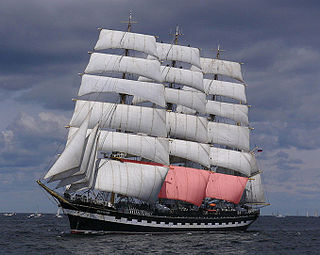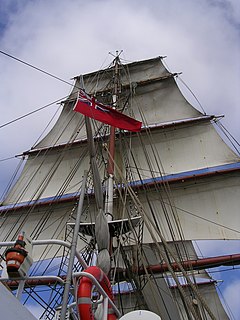This article needs additional citations for verification .(October 2018) |


In sailing, a sheet is a line (rope, cable or chain) used to control the movable corner(s) (clews) of a sail. [1] [2]
This article needs additional citations for verification .(October 2018) |


In sailing, a sheet is a line (rope, cable or chain) used to control the movable corner(s) (clews) of a sail. [1] [2]
In nautical usage the term "sheet" is applied to a line or chain attached to the lower corners of a sail for the purpose of extension or change of direction. The connection in derivation with the root "shoot" is more clearly seen in "sheet-anchor", one that is kept in reserve, to be "shot" in case of emergency. [1] [3]
Fore-and-aft rigs comprise the vast majority of sailing vessels in use today, including effectively all dinghies and yachts. The sheet on a fore-and-aft sail controls the angle of the sail to the wind, and should be adjusted to keep the sail just filled. Most smaller boats use the Bermuda rig, which has two or three sets of sheets:
On the smallest boats, a sheet is often a simple line, pulled by hand; on larger boats, intermediate blocks are sometimes used to provide mechanical advantage. However, many blocks and their multiply reeved lines, particularly on headsails, have been replaced by single-line sheets trimmed by powerful winches.
Square-rigged vessels are much less common, and are usually large ships. Nevertheless, they too have sheets on the movable corners of their square sails. Unlike fore-and-aft sheets, though, square-rig sheets do not control the angle of the sails (which is performed using braces); instead, they are used to haul the corners of the sails from their stowed positions down towards the tip of the yard below. They are then not adjusted significantly while sailing until the sail is to be handed (put away) again. The lowest sails, the courses, are trimmed using the sheets as these sails are loose footed and are secured to yards only at the head.

A sail plan is a description of the specific ways that a sailing craft is rigged. Also, the term "sail plan" is a graphic depiction of the arrangement of the sails for a given sailing craft.
A jib is a triangular sail that sets ahead of the foremast of a sailing vessel. Its tack is fixed to the bowsprit, to the bows, or to the deck between the bowsprit and the foremost mast. Jibs and spinnakers are the two main types of headsails on a modern boat.
A tack is a nautical term both for the lower, windward corner of a sail and, separately, for the windward side of a sailing craft (side from which the wind is coming while under way—the starboard or port tack. Generally, a boat is on a starboard tack if the wind is coming over the starboard side of boat with sails on port side. Similarly, a boat is on a port tack if the wind is coming over the port side of boat. However, confusion can result when a boat is on a 'run', with the wind coming directly from astern and the mainsail and jib/genoa are on opposite sides of the vessel. Therefore, the windward side is defined as the side opposite to that on which the mainsail is being carried. On a starboard tack the mainsail is carried on the port side. On a port tack the mainsail is carried on the starboard side. It is the position of the mainsail that determines the tack.

A jibe (US) or gybe (Britain) is a sailing maneuver whereby a sailing vessel reaching downwind turns its stern through the wind, which then exerts its force from the opposite side of the vessel. For square-rigged ships, this maneuver is called wearing ship.

A spinnaker is a sail designed specifically for sailing off the wind from a reaching course to a downwind, i.e. with the wind 90–180° off bow. The spinnaker fills with wind and balloons out in front of the boat when it is deployed, called flying. It is constructed of lightweight fabric, usually nylon, and is often brightly colored. It may be optimised for a particular range of wind angles, as either a reaching or a running spinnaker, by the shaping of the panels and seams.

A mainsail is a sail rigged on the main mast of a sailing vessel.

Running rigging is the rigging of a sailing vessel that is used for raising, lowering, shaping and controlling the sails on a sailing vessel—as opposed to the standing rigging, which supports the mast and bowsprit. Running rigging varies between vessels that are rigged fore and aft and those that are square-rigged.
A gybe preventer, preventer, or jibe-guard, is a mechanical device on a sailing vessel which limits the boom's ability to swing unexpectedly across the boat due to an unplanned accidental jibe.

A Bermuda rig, Bermudian rig, or Marconi rig is a configuration of mast and rigging for a type of sailboat and is the typical configuration for most modern sailboats. This configuration was developed in Bermuda in the 1600s; the term Marconi, a reference to the inventor of the radio, Guglielmo Marconi, became associated with this configuration in the early 1900s because the wires that stabilize the mast of a Bermuda rig reminded observers of the wires on early radio masts.

Square rig is a generic type of sail and rigging arrangement in which the primary driving sails are carried on horizontal spars which are perpendicular, or square, to the keel of the vessel and to the masts. These spars are called yards and their tips, outside the lifts, are called the yardarms. A ship mainly rigged so is called a square-rigger.

Sail components include the features that define a sail's shape and function, plus its constituent parts from which it is manufactured. A sail may be classified in a variety of ways, including by its orientation to the vessel and its shape,. Sails are typically constructed out of flexible material that is shaped by various means, while in use, to offer an appropriate airfoil, according to the strength and apparent direction of the wind. A variety of features and fittings allow the sail to be attached to lines and spars.

In sailing, a boom is a spar (pole), along the foot of a fore and aft rigged sail, that greatly improves control of the angle and shape of the sail. The primary action of the boom is to keep the foot flatter when the sail angle is away from the centerline of the boat. The boom also serves as an attachment point for more sophisticated control lines. Because of the improved sail control it is rare to find a non-headsail without a boom, but lateen sails, for instance, are loose-footed. In some modern applications, the sail is rolled up into the boom for storage or reefing.

The spritsail is a four-sided, fore-and-aft sail that is supported at its highest points by the mast and a diagonally running spar known as the sprit. The foot of the sail can be stretched by a boom or held loose-footed just by its sheets. A spritsail has four corners: the throat, peak, clew, and tack. The Spritsail can also be used to describe a rig that uses a spritsail.

A spinnaker pole is a spar used in sailboats to help support and control a variety of headsails, particularly the spinnaker. However, it is also used with other sails, such as genoas and jibs, when sailing downwind with no spinnaker hoisted.

A fractional rig on a sailing vessel consists of a foresail, such as a jib or genoa sail, that does not reach all the way to the top of the mast.

The junk rig, also known as the Chinese lugsail or sampan rig, is a type of sail rig in which rigid members, called battens, span the full width of the sail and extend the sail forward of the mast.

The Bermuda Fitted Dinghy is a type of racing-dedicated sail boat used for competitions between the yacht clubs of Bermuda. Although the class has only existed for about 130 years, the boats are a continuance of a tradition of boat and ship design in Bermuda that stretches back to the earliest decades of the 17th century.

The log canoe is a type of sailboat developed in the Chesapeake Bay region. Based on the dugout, it was the principal traditional fishing boat of the bay until superseded by the bugeye and the skipjack. However, it is most famous as a racing sailboat, and races continue to be held.

A sail is a tensile structure—made from fabric or other membrane materials—that uses wind power to propel sailing craft, including sailing ships, sailboats, windsurfers, ice boats, and even sail-powered land vehicles. Sails may be made from a combination of woven materials—including canvas or polyester cloth, laminated membranes or bonded filaments—usually in a three- or four-sided shape.
The following outline is provided as an overview of and topical guide to sailing: